There are various connection preferences that may be used to define how users may connect to domain services you create. These preferences may be managed under the "Connections" and "Services" nodes.
General connection settings apply to all file transfer protocols including FTP, FTPS (FTP over SSL), SFTP (FTP over SSH), HTTP/S and WebDAV and may be set using the "Connections" node.
Figure 28
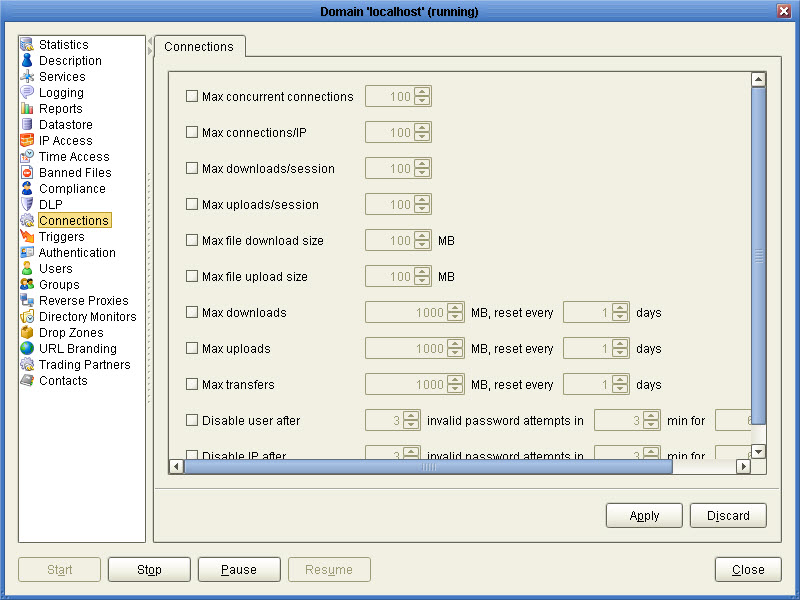
Max Concurrent Connections - The maximum number of concurrent connections allowed. Note: This value may not exceed the concurrent connection limit of your license type.
Max Connections/IP - The maximum number of active connections from a single client IP address.
Max Downloads/Session - The maximum number of downloads per client session.
Max Uploads/Session - The maximum number of uploads allowed per client session.
Max File Download Size (MB) - The maximum file download size in MB.
Max File Upload Size (MB) - The maximum file upload size in MB.
Max Uploads (MB) - Defines an upload quota for the domain that is reset every N days. If upload quota is exceeded no further uploads are allowed until upload quota is reset.
Max Downloads (MB) - Defines a download quota for the domain that is reset every N days. If download quota is exceeded no further downloads are allowed until download quota is reset.
Max Transfers (MB) - Defines a transfer quota for the domain that is reset every N days. If transfer quota is exceeded no further file transfers are allowed until transfer quota is reset. Transfers are the combined sum of uploads and downloads.
Disable account after X invalid password attempts in Y min - Disables account for a certain period of time if too many login attempts fail within a certain period of time.
Block IP after X invalid password attempts in Y min - Blocks IP from further access for a certain period of time if too many login attempts fails within a certain period of time.
FTP connection settings apply to FTP and FTPS (FTP over SSL) file transfer protocols. These settings may be managed under the "Services" node in the "FTP/S" panel.
Figure 70
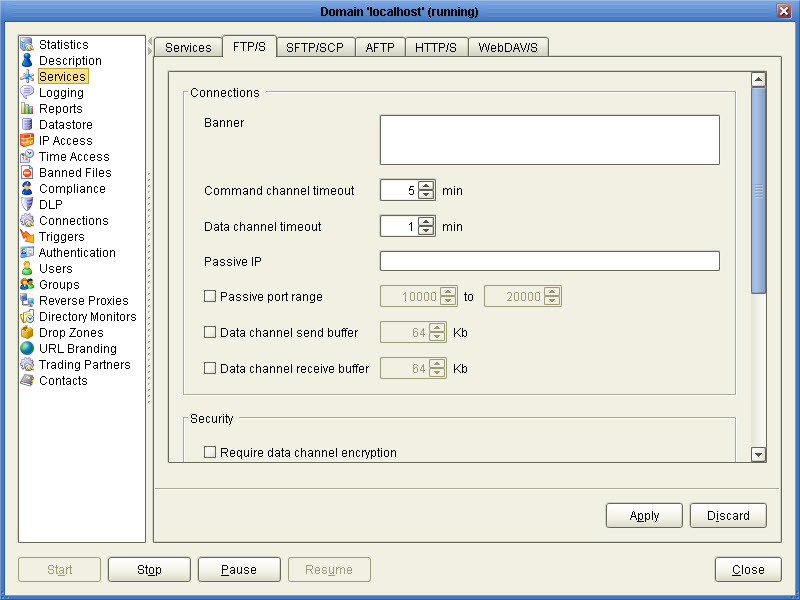
Connections
Banner - The banner to display to FTP clients.
Command channel timeout (min) - The time in minutes that a client may remain inactive on command channel before server forcefully disconnects client.
Data channel timeout (min) - The time in minutes that a client may remain inactive on data channel before server forcefully disconnects client.
Passive IP - The IP to use when responding to PASV client requests.
Passive port range - The port range on the server to use for servicing PASV client requests.
Data channel send buffer - The size of send buffer for data channel. Default is send buffer size for JVM.
Data channel receive buffer - The size of receive buffer for data channel. Default is the receive buffer size for JVM.
Security
Require data channel encryption - If enabled client will be required to encrypt data channel when using FTPS (FTP over SSL) protocol.
Require client certificate - If enabled users authenticating using FTPS (FTP over SSL) will be required to authenticate using data encrypted with a private key that maps to a server installed client certificate.
Require client certificate for data channel - If enabled users requesting data transfer using FTPS (FTP over SSL) will be required to supply data encrypted with a private key that maps to a server installed client certificate.
Block PASV attack - If enabled users will only be allowed to connect to passive data ports that are initiated by same client on command channel.
Shutdown SSL for CCC command - If enabled client must properly shutdown SSL connectiosn for command channel when issuing CCC command.
Shutdown SSL for data connection - If enabled client must properly shutdown SSL data connections.
SSL Ciphers - The SSL ciphers to enable for FTPS (FTP over SSL) services.
SFTP/SCP connection settings apply to SFTP and SCP file transfer protocols. These settings may be managed under the "Services" node in the "SFTP/SCP" panel.
Figure 71
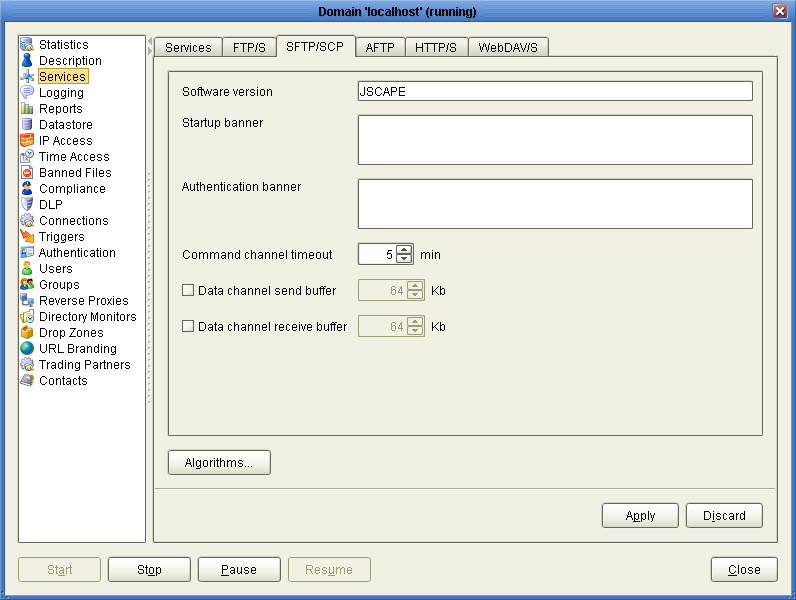
Connection timeout (min) - The time in minutes that client connection may remain inactive before server forcefully disconnects client.
Send buffer - The size of send buffer. Default is send buffer size for JVM.
Receive buffer - The size of receive buffer. Default is the receive buffer size for JVM.
Software version - The SSH version banner displayed when connecting.
Startup banner - The banner to display to SFTP clients prior to displaying SSH version banner.
Authentication banner - The banner to display to SFTP clients prior to displaying authentication prompt.
Key Exchange, Ciphers, MACs, Compressions - Lists all algorithms, their order of preference and whether they are enabled.
See also
Additional libraries needed for SFTP ciphers
AFTP connection settings apply to AFTP (Accelerated File Transfer Protocol). These settings may be managed under the "Services" node in the "AFTP" panel.
Figure 163
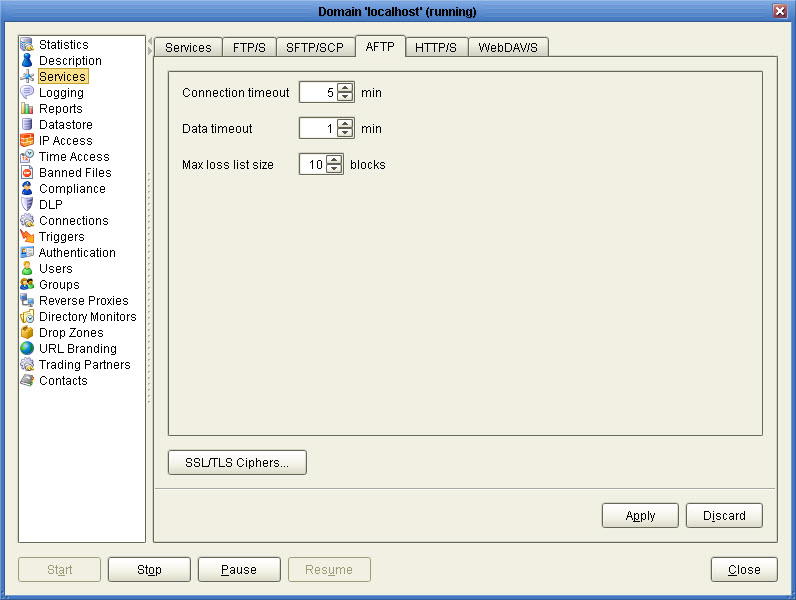
Connection timeout (min) - The time in minutes that client connection may remain inactive before server forcefully disconnects client.
Max loss list size - The maximum number of lost blocks of data that may exist in memory for a client session.
HTTP/S connection settings apply to HTTP and HTTPS protocols. These settings may be managed under the "Services" node in the "HTTP/S" panel.
Figure 89
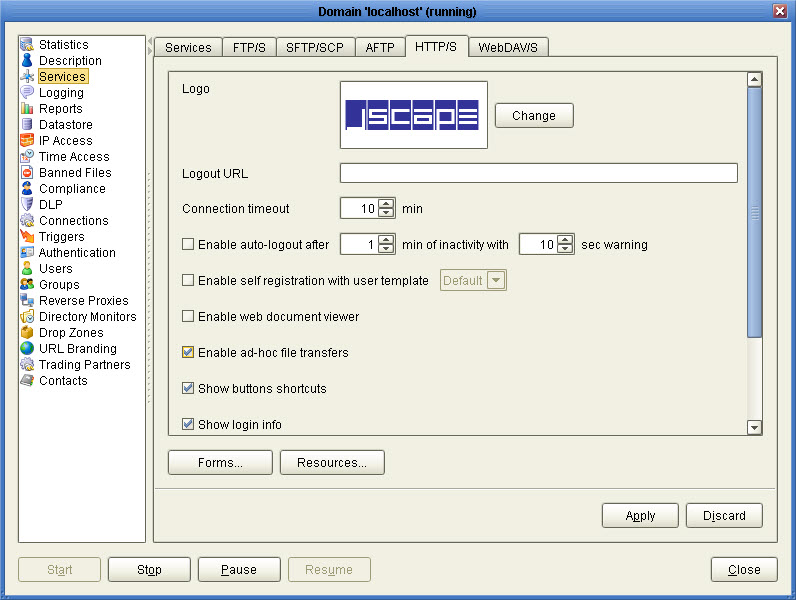
Logo - The logo displayed in upper left corner when using HTML user interface.
Logout URL - The URL to redirect user to upon clicking Logout link.
Connection timeout - The connection timeout for HTTP requests in minutes.
Language - The current language resource file. Language resource files are used for specifying alternative user interface labels based on client browser default language.
Enable automatic logout - If checked, user will be automatically logged out after X minutes of inactivity with grace period of Y seconds.
Enable web document viewer - If checked web document viewer is enabled.
Use Flash upload component - If enabled the Macromedia Flash plug-in will be used for performing file uploads when using HTML user interface. This plug-in is useful in that the select files dialog allows users to select more than one file at a time for upload whereas the browser select file dialog only allows one file to be selected at a time.
Note: Starting with version 8.x of JSCAPE MFT Server the browser select file dialog supports selection of multiple files. The Macromedia Flash plugin can be used with both HTTP and HTTPS protocols. However, when using HTTPS the server certificate MUST be issued by a trusted CA (certificate authority) as self-signed certificates are not recognized by Macromedia Flash. See Obtaining a trusted certificate for details.
Enable ad-hoc file transfers - If checked ad-hoc file transfers will be enabled for the domain.
Show buttons shortcuts - If checked, button shortcuts (e.g. F2, F5, F7) are displayed on buttons.
Show login info - If checked, the current username and domain is displayed in upper right.
Show search - If checked searches on indexed documents may be performed.
Show ASCII/Binary option - If checked, user has option of uploading files in both ASCII and binary modes. If unchecked only binary is allowed by default and user does not have ability to change this setting.
Show account link - If checked the My Account link is displayed in upper right allowing users to change their account contact information.
Setup Forms - Forms available during file upload when using HTML user interface.
WebDAV/S connection settings apply to WebDAV and WebDAV over SSL protocols. These settings may be managed under the "Services" node in the "WebDAV/S" panel.
Figure 90

Logo - The logo displayed in upper left corner when using WebDAV user interface.
Logout URL - The URL to redirect user to upon clicking Logout link.
Language - The current language resource file. Language resource files are used for specifying alternative user interface labels based on client browser default language.
Enable Java applet - If checked, Java applet interface is enabled for WebDAV connections.
Enable web document viewer - If checked web document viewer is enabled.
Show login info - If checked, the current username and domain is displayed in upper right.
Show account link - If checked the My Account link is displayed in upper right allowing users to change their account contact information.